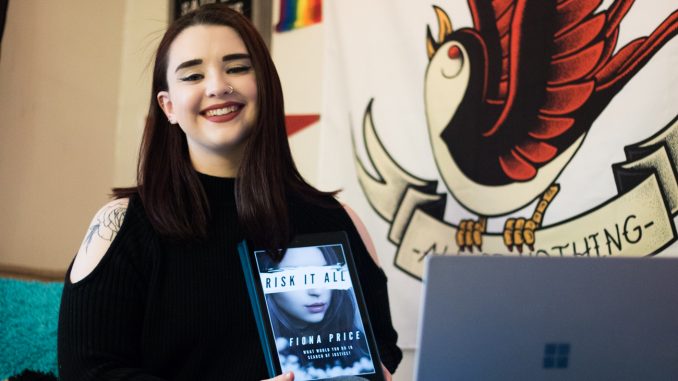
When she began writing in 2012, Fiona Sanderson never thought about publishing her stories.
“I thought the process would be long and drawn out,” she said.
Sanderson, a freshman nursing major, believed the only way to publish her books was landing a book deal. After discovering she could self-publish through Amazon, though, she decided to share her two books, “Driven” and “Risk It All,” online under the pen name Fiona Price.
“The process was so easy,” Sanderson said. “I have been so happy with publishing my books through this independently. I have a lot of freedom and I feel that it’s less stressful than trying to submit a manuscript to different publishing companies and different editors.”
Her most recent novel, “Risk It All,” which released in February, tells the fictional story of former police detective Alissa Montgomery, who investigates the murder of her fiance — a crime she has been wrongfully accused of. The buddy cop romance story includes themes surrounding the LGBTQ community, like sexuality and self-identity.
Sanderson, who identifies as bisexual, was inspired to write her book after noticing the lack of LGBTQ representation in books and television. She wanted more bisexual representation and non-hypersexualized lesbian relationships, so she chose to write stories that reflected her identity and others in the community.
“Oftentimes, in movies, books and real life, when someone who is bisexual is in a relationship with someone of the opposite sex, many then erase the bisexual identity because they’re in a straight relationship,” she said. “I’d like to see more people change their mindsets about bisexual relationships and that a person is still bi even when they’re in a straight pairing.”
Sanderson said this is why one of her favorite parts about writing is developing characters who share her own feelings and experiences.
Avery Figueiredo, a junior criminal justice major who identifies as lesbian, said she didn’t think much of queer representation in books because she felt there wasn’t any to begin with.
“There was maybe a character here or there but never a main character with a developed character and storyline,” she said.
Having a developed character with background information was essential for Sanderson to avoid oversexualization or use the relationship only to advance the plot. Instead, Sanderson took the time to develop each character’s backstories and gradually build their chemistry throughout the book.
“I wanted to have a very enjoyable and readable storyline as the LGBT part of the character at the center, without it being too crazy and over the top,” Sanderson said.
In addition to increased representation, Brad Windhauser, an English and gender, sexuality and women’s studies professor, said today’s queer stories include more variety and intersectionality compared to those in the 1970s which usually ended in tragedy.
“Our characters are living more interesting lives on the page, and they tend to have a lot more depth and a lot more complexity in ways that they haven’t before,” he said.
Sanderson wants to continue improving her writing skills and learning how to develop characters that give authentic representation. As for her next book, Sanderson doesn’t have an exact release date in mind just yet.
“I have a few stories that I have written over the years that I’m currently editing right now,” Sanderson said. “I don’t have a strict time plan for their release because often I feel when it’s ready.”


Be the first to comment